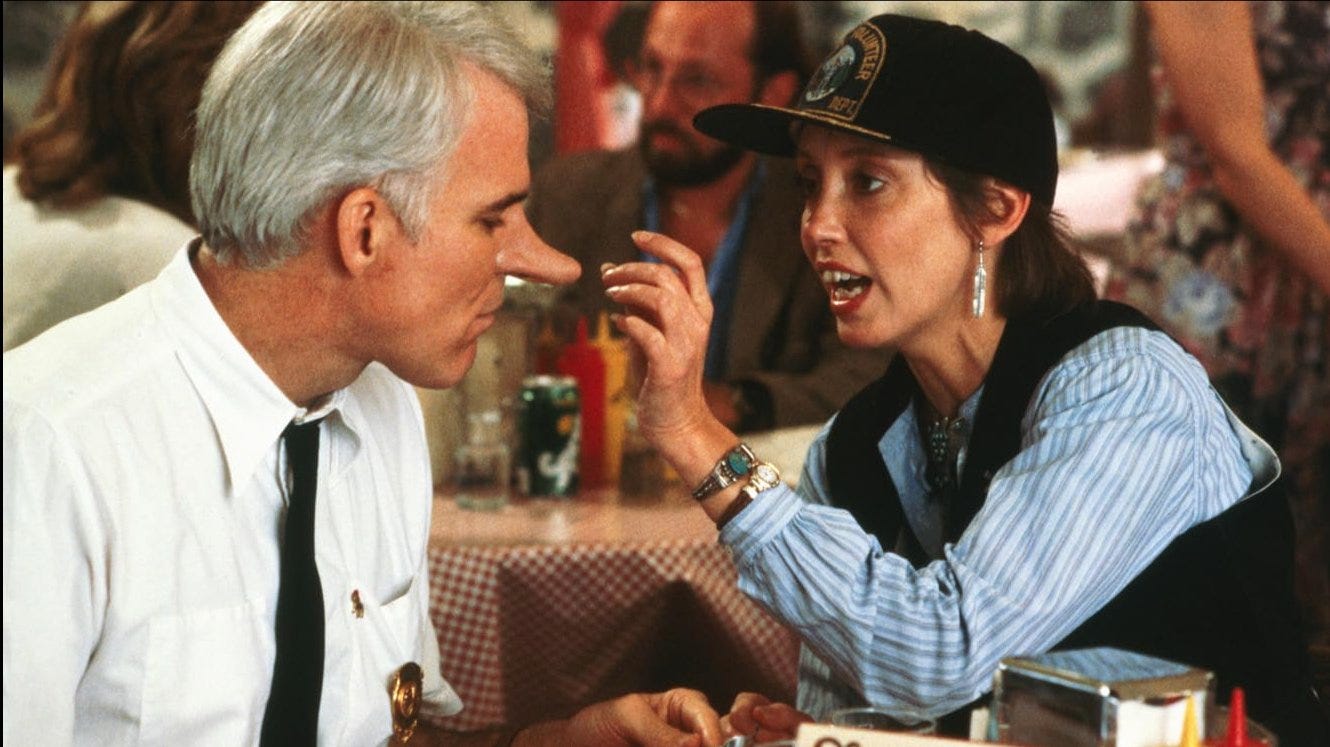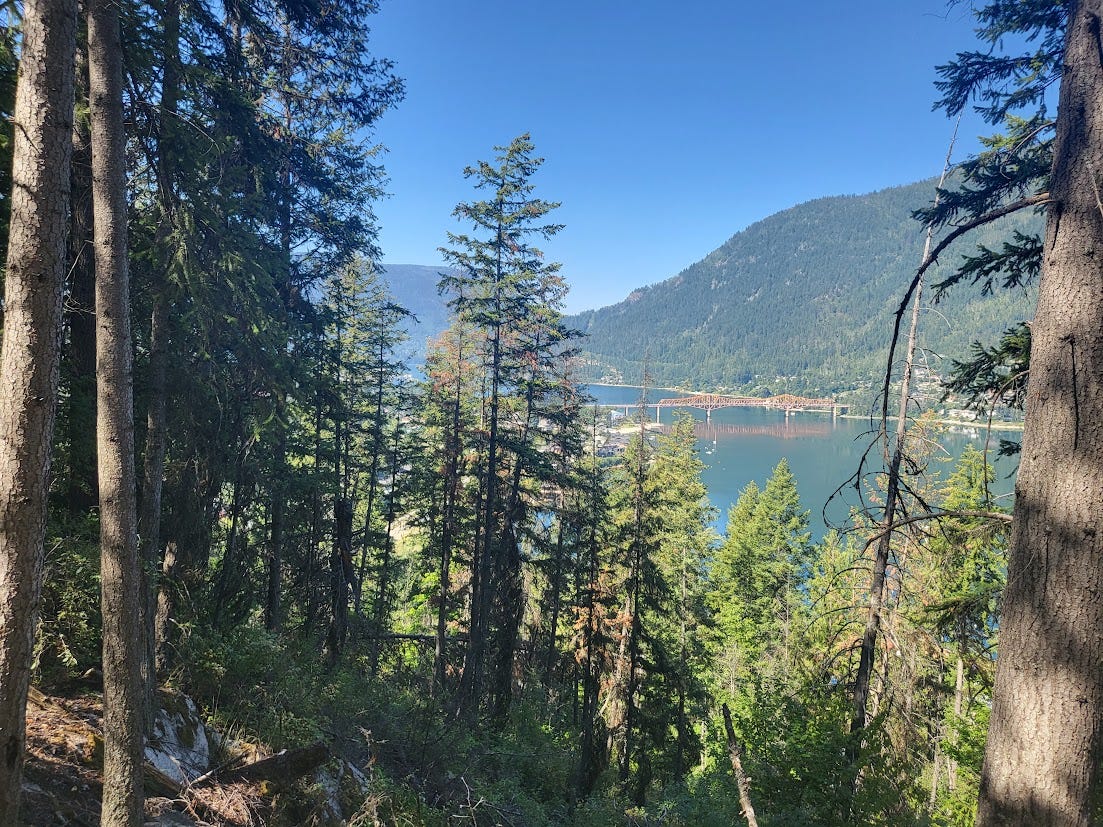I never thought a movie about a man with an enormous nose would lead me on a decades-long quest. But, well, here we are. In the summer of 1987, Steve Martin's “Roxanne” hijacked my life’s trajectory like a big red truck headed the wrong way to a housefire.
I was living near Boston, working a 9-to-5 job, when I spent a weekend visiting Chasmo in the Berkshires. We saw “Roxanne” on a big screen in a nearby village. I walked out of the theater into a humid dusk and said, “I want to move to that kind of town.”
Shelley Duvall’s death this month reminds me of that moment, because her character Dixie was an essential element of the movie’s vibe. But in truth I’m constantly reminded of that moment, because I do live in that kind of town.
In the months after seeing the movie, I tried to find out where it was filmed, which was not easy pre-Internet. In the movie’s world, the town is called Nelson, Washington, but there is no such place. The filming location was Nelson, British Columbia—and when I somehow finally learned that, I stopped thinking about it as a real place in my life.
Obviously no movie location is real, and I’ve actually preferred real life at the locations of “The Truman Show,” “A Change of Seasons,” and “The Big Chill” to the films themselves. But in this case, I knew that I didn’t want to move to Canada. I didn’t need to visit Nelson, because that wasn’t what I wanted. I wanted the US town that could match the movie’s vibe.
Walkability, historic downtown, and access to nature. I remembered CD Bales (the Martin character) walking home after a tennis match. I remembered the scene when he has to tell 20 jokes about his nose—and the whole tavern goes quiet because everyone knows him and wants him to succeed. I remembered Dixie and CD going out for an afternoon hike on a mountain trail, having some conversation that was essential to the plot. And I remembered wanting that: to be friends with Dixie and the fire chief and everyone else in the giant tavern, to have big verdant mountains as backdrops to my backstories.
I understood—or maybe I didn’t—that the movie-town was a fairytale, a romantic comedy that could not be replicated in real life. I would never encounter a beautiful woman saying, "No, I'm fine standing naked out here in the cold," much less spend the coming months seducing her with language. Still, the setting felt important. If I was drawn to the scenery in this movie, that said something about me. Maybe I should pursue it.
And I did, sort of. Three years later I recognized elements of that vibe in a town in Montana. I’ve been here ever since.

Five years ago I finally visited Nelson, BC, and took the self-guided walking tour of movie sites. I was especially pleased to drink a beer at Dixie’s old café, though everyone in there had totally average-sized noses. Nevertheless, the streets caught that spirit I’d felt in the movie: the hilly residential neighborhoods, the bookstore, the still-active firehall. And I was still drawn to it.
I was shocked to learn, first, that the movie had captured a genuine community character, and second, how it had come about. Nelson had been founded in the 19th century silver rush, on Sinixt (Lakes) and Ktunaxa (Kutenai) lands. It later boasted a sawmill and served as a railroad hub. But in the latter half of the 20th century, its economy floundered. The mill closed, a mall decimated the historic downtown. Nobody could afford to build new buildings, so they just cladded the old ones with cheap siding.
The only bright spot: during the Vietnam War, the mild climate and proximity to the border attracted lots of draft-dodgers. These expats were among the leaders who decided that Nelson should pursue an arts-based economy. They noticed that restored historic buildings had thrived in Vancouver and Victoria; why not try restoring a small mountain town as well? They took off the siding and pulled out the paint. The movement was just hitting its stride when the location scouts came by.
The scouts wanted something unique, romantic, and cutting-edge. Many small old mountain towns had not yet embraced historic renovation. The few that had (Aspen, Telluride…) tended to be overly touristy, dominated by big-money ski resorts. Nelson—which would soon also be home to one of the Rockies’ first microbreweries—could at least give the impression that it was doing this work for the sake of the community itself.
Nelson was full of people who liked a natural backdrop to their everyday conversations. Who punctuated their daily routines with mountain hikes. Who rehabbed historic buildings for the pleasure of it. Who, when a certain movie star came to work in their town, loved her. “I've never seen an entire town profess its affection for someone like it did for Shelley Duvall,” a local reported this month.
That was the vibe I had felt in the movie: its star wasn’t necessarily Steve Martin or a funny-looking nose, but the physical evidence of a thriving community. To craft my own life, I didn’t need those particular Canadian people, that particular town and its already-rehabbed historic district. I just needed the vibe they set off like a virus.
Should we be surprised that I found it? Or is that how natural stories work?
Shelley Duvall probably doesn’t get enough credit for enlivening the script’s bland best-friend-in-the-romcom role. (Among her lines, to CD: “So, why don't you ask her out?” and later, “Tell Roxanne that you love her.” Also, thankfully, “It's a riddle. What can you sit on, sleep on, and brush your teeth with?”)
But to me the real heroes of “Roxanne” were the location scouts. They found the setting—which also doesn’t get enough credit for enlivening this natural story.
Discussion:
Dixie’s answer to her riddle: “A chair, a bed, and a toothbrush…. sometimes the answer is so obvious, you don't even realize it. It's as plain as the nose on your face. You should tell her!” So yeah, she did a lot with what little the script gave her.






I’d forgotten about this movie!
Nelson, British Columbia? And you moved 3000 miles because of a Rom Com?
Dude....